Hanover Bald Eagle Blog # 13 - 2021
March 29, 2021
In partnership with Pennsylvania Game Commission and Comcast Business .
The Hanover nestling is growing FAST! Already, they (gender-neutral pronoun since we don’t know if it’s she or he!) are sitting upright, greeting the adults, chirping with more vigor, and taking larger pieces of food. They are now able to thermoregulate on their own, so while the parents still provide warmth at times, soon the nestling will be more and more independent within the nest. Parents constantly watch over the little one for the first three weeks, but by the fifth and six weeks we will see a sharp decrease in the amount of time the adults spend inside the nest. Fear not – they will still roost and sleep nearby!
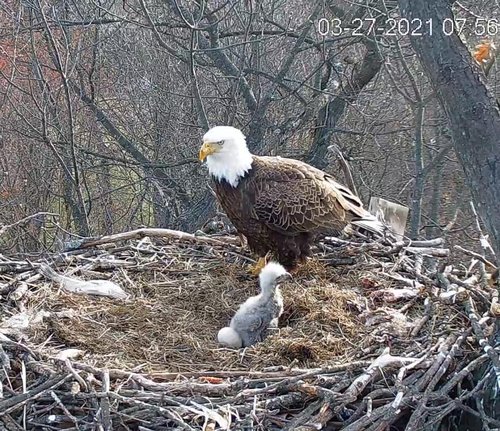
As mentioned earlier in the season, bald eagles have fewer nest predators than most birds, but they still need to protect their young during the first month of growth. Great-horned owls will take advantage of a nest if they have the opportunity, and as we’ve seen, even other bald eagles are willing to try their luck at usurping the Hanover nest.
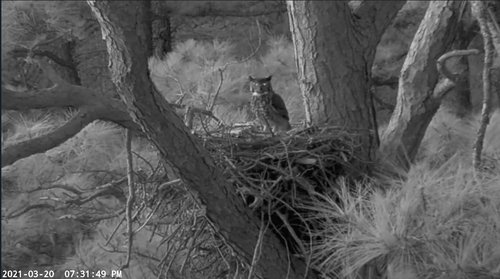
A Great Horned Owl taking over an eagle nest near Blackwater National Wildlife Refuge in Maryland.
These events – when an outside bald eagle causes trouble – are called intruder events.
Intrusions are usually initiated by “floaters,” meaning adult eagles without territories. If there are not enough nesting territories to support all mature adults in an area, some end up without a job for the breeding season. More seriously, they end up without a mechanism for passing on their genes, a circumstance that most living things strictly avoid. So, they go shopping for already-occupied sites.
In a study conducted in northern Minnesota in 1987, researchers addressed the various factors affecting territorial behavior in bald eagles during the nesting season. They assessed several factors including the “internal state [of the bird], extent of previous ‘ownership,’ [of the nest], ‘attitude’ of intruder, type of activity of defending bird, weather conditions, and time of day.”
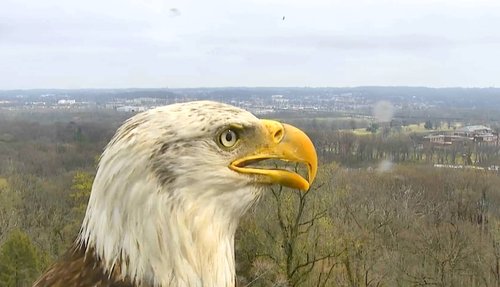
V5 looks ahead as an intruder is seen flying over in the distance at the National Arboretum Eagle Nest in Washington, D.C.
To take a deeper look at the incentives behind territorial behavior, the researchers wanted to determine which factors caused bald eagles to react in the strongest way. To accomplish this, they dreamt up a creative study design: They erected bald eagle “intruder” replicas (including a papier-mâché eagle!) and monitored the territorial responses at 16 active nests. Here is what they found:
-- Territorial defense was strongest during the first two weeks after the eggs hatched, which follows the trend seen in other raptor species. Typically, adults defend the nest less and less as the nesting season progresses.
-- The response to decoys was greatest when they were noticed from across a body of water. The authors speculated that this was because as fish-eaters, bald eagles nesting near lakes may consider the lake an extension of their nesting territory, since it contains their primary food source. There also may be higher visibility of intruders across bodies of water, meaning that a nesting pair of eagles can see intruders more easily (and sooner) if they are near a lake versus at a terrestrial site with trees and other obstacles obscuring their view.
-- They also speculated that eagle pairs nesting on land may have greater tolerance for disturbances than those near water.
These researchers ran their experiment in 1979, and then again in 1980, with the same results, demonstrating consistency in their findings.
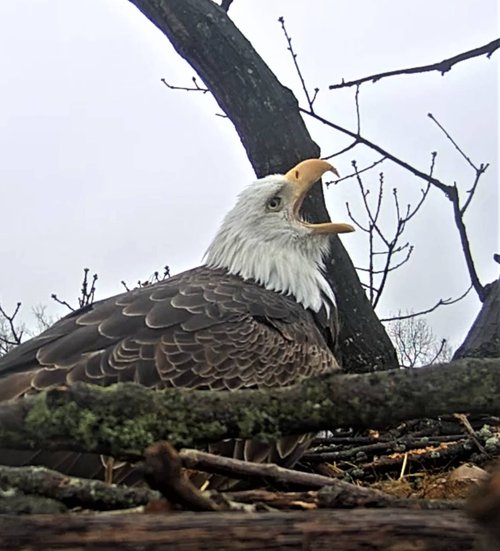
The female eagle in Hanover begins to sound the alarm to ward off an intruder flying overhead.
Defensive nest behaviors range from attacking and chasing, circling the nest, perching nearby as a precaution, or vocalizing. Threat vocalizations are thought to be a preventative measure, lessening the need for physical contact. These calls are often accompanied with an extended neck, raised hackles (the feathers on the back of the neck), head thrown back, crouching, and raised wings. These behaviors can be energetically demanding for parents, and breeding success can be compromised by intrusion events if they become frequent and intense enough to jeopardize the parent’s ability to care for their young.
Researchers have observed a stark increase in the number of intrusion events in the Chesapeake Bay area as a result of soaring bald eagle numbers. Between 1990 and 2013, the number of floaters in the Chesapeake Bay region increased 5-fold!
However, not all intrusions are viewed as equal by nesting adults.
Over time, breeding parents may become less defensive towards other individual eagles such as a neighboring pair they recognize, or even the same intruder. A pair may also loosen up against an intruder if they are routinely harassed with no consequences, perhaps deciding that the energy expenditure isn’t worth the threat. A pair may also defend less vigorously against a juvenile than an adult eagle, because juveniles are not yet ready to breed, so their incentive for attacking is less serious and likely less consequential.
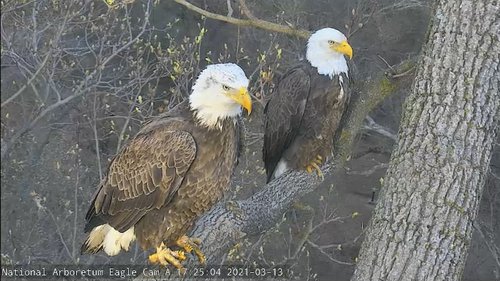
One of the visitors at the National Arboretum Nest in Washington, D.C. (V5, left) seen here with the resident male (Mr. P, right), became so familiar with frequent visits that they began bonding and copulating.
Even though we have witnessed the occasional floater visiting the Hanover nest, that does not mean the area is over-saturated or that there are floaters flying amuck. Nests in the Chesapeake Bay where eagle populations have reached what researchers call “saturation,” deal with intrusions multiple times per day. That is significantly more than the Hanover nest must deal with, implying that the eagles here have not reached saturation.
The increase of intrusion events puts a fascinating spin on the bald eagle comeback from the brink of extinction. Who would have thought in the 1950’s that there would come a day when a population could become saturated! It’s important to remember that floaters are not inherently bad. Rather, they are a natural result of population dynamics: if most mature bald eagles fledge young every year, those young will eventually breed, eventually causing the population to reach “carrying capacity” once there are no longer enough resources for every eagle to successfully produce young. Floaters, understandably motivated, and understandably annoying for the Hanover parents, are understandably natural.
Sources
Courtney Turrin, Bryan D. Watts "Intraspecific Intrusion at Bald Eagle Nests," Ardea, 102(1), 71-78, (1 July 2014).
Buehler, D. A. (2020). Bald Eagle (Haliaeetus leucocephalus), version 1.0. In Birds of the World (A. F. Poole and F. B. Gill, Editors). Cornell Lab of Ornithology, Ithaca, NY, USA. https://doi.org/10.2173/bow.baleag.01
ATTENTION HANOVER EAGLE VIEWERS - We recognize that over the years this bald eagle pair has been named by the public and is commonly referred to as "Freedom" and "Liberty". While we understand that naming the eagles helps connect and distinguish the female from the male eagle, naming the pair introduces an element of domesticity to wild animals. In order to respect the eagles and focus on their natural history, we will refer to the female and male as such as per recommendations of the Pennsylvania Game Commission.
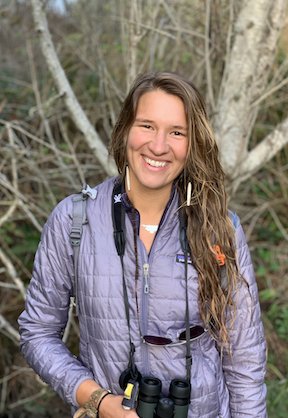

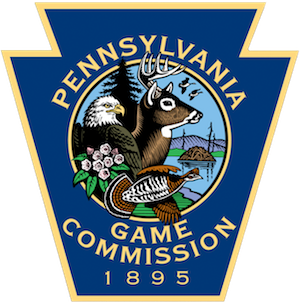
RAPTOR ECOLOGY SPECIALIST - ZOEY GREENBERG
RETURN TO HANOVER BALD EAGLE BLOGS
WATCH THE HANOVER BALD EAGLE LIVE CAMS
For over 20 years, HDOnTap has provided live streaming solutions to resorts, amusement parks, wildlife refuges and more. In addition to maintaining a network of over 400 live webcams, HDOnTap specializes in design and installation of remote, off-grid and otherwise challenging live streaming solutions. Contact press@hdontap.com for all media needs, including images and recordings.